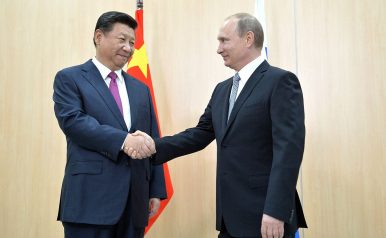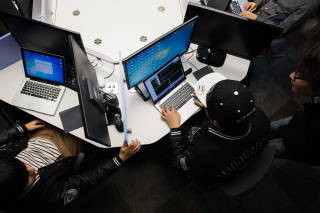http://www.livemint.com/Opinion/GxkTd5CNtdJGH1HjfutGXN/Indias-strategic-unicorn-in-Chabahar.html
The security dimension of Chabahar is based on a preferential approach towards Indian interests rather than one based on exclusivity by Iran
File photo of the Chabahar port. It is imperative to remember that Chabahar is an SEZ and not an exclusive project handed over to India. Photo: AP
India’s external affairs minister, Sushma Swaraj, made an unscheduled stop in Tehran on her way back from Russia, weeks after India flagged off the first shipments of wheat to Afghanistan using the much anticipated Chabahar port, on Iran’s south-eastern seaboard. The port, inaugurated by Iran’s President Hassan Rouhani a day after Swaraj’s visit, is marketed as a strategic home run by New Delhi. However, after more than a decade of abstraction, the very concept of “strategy” eludes this flagship undertaking.
Delhi and Tehran have maintained amicable and warm ties throughout times of challenges and global uncertainties. Chabahar has, in a strange way, become a metric to gauge how close the two countries have remained during times of crisis over Western sanctions on Iran, and India’s votes against the country at the UN under American duress. Perhaps, as a reaction, Iran’s supreme leader, Ayatollah Khamenei, for the first time in seven years, this June flagged Kashmir as a place where “tyrants” are oppressing Muslims, initiating one of many micro-diplomatic crises that crop up between the two countries at regular intervals.
The recent upticks in Chabahar and its access to Afghanistan, bypassing the conundrum of Pakistan that obstructs both Delhi and Kabul, is a positive and long overdue achievement. It solidifies the often contentious relations between the two countries over India’s economic commitments in Iran, which go beyond the port project. It is imperative to remember here that Chabahar is a Special Economic Zone (SEZ) and not an exclusive project handed over to India, and Iran has reiterated this point multiple times. In 2016, Delhi offered to invest $20 billion in Iran, money that many highlight it doesn’t have. Compared to Beijing’s already full control of Gwadar, China has already activated a $10 billion credit line to Tehran, with another $15 billion one close to fruition. China’s Belt and Road Initiative (BRI), as per Iranian officials quoted in the media, has been successful in taking large chunks of projects away from Western companies, with some estimates suggesting Beijing is now controlling double the amount of annual Iran-European Union annual trade ($10 billion, as per figures from the first half of 2017) with Tehran.
However, Chabahar has got an altogether different lease of life in the Indian discourse compared to the Iranian one. India’s access to Chabahar is predominantly seen as a counter-balance to the port of Gwadar, on the south-western coast of Pakistan’s restive Balochistan province, run almost entirely by China as a part of its expansive China-Pakistan Economic Corridor (CPEC). In fact, Chabahar and Gwadar even have a sister-cities agreement, promoting trade and people-to-people ties between the ports even as New Delhi pitches the two against each other.
India’s fears stem from the possibility of a build-up of Chinese naval presence in the near future, with China committing around $60 billion in infrastructure investments in Pakistan. Some analysts believe the protection of this vast investment will lead China to increase its military footprint in the seas around South Asia. To put it in perspective, 2013 saw no Chinese naval submarines in the waters of the Indian Ocean, while this has jumped to an average of seven-eight such ships in 2017. While these movements include anti-piracy operations, it raises the question of why submarines are required to tackle glorified tugboats and modified motorboats off the African coast. These movements, of course, are now backed further by Beijing’s first overseas permanent military installation in Djibouti, where the Chinese conducted their first live-fire exercises last month. The probability of such a build-up weighs heavy on Indian strategists’ minds, and Chabahar is often seen as the ideal balancing option. The realities in India’s Chabahar thrust have been different. Beyond economic feasibility, the strategic bogey has limited functionalities as a hypothesis.
Despite both India and Iran peddling the overhyped narrative of “civilizational ties” being the bedrock of the bilateral relationship, it is, in fact, hard, unemotional economics that drives the engagement. Iran, which has a reputation of being a difficult friend and customer, sanctions or no sanctions, has also not made things easy for New Delhi and its successive governments. The trade of hydrocarbons is the largest chunk of Indo-Iranian ties, and, at the peak of American sanctions against Tehran over its nuclear programme, India had the hard task of balancing American pressure in order to minimize any long-term damage between the two countries as Iran pushed for financial clearances from India to the tune of nearly $6 billion in pending oil payments. Even as India informed Iran of its inability to do so, due to sanctions, the then government of president Mahmoud Ahmadinejad persisted, often threatening New Delhi that it could lose stakes in projects such as Chabahar port, the Farzad B gas field and so on if it did not defy Washington.
Emerging from those times relatively unscathed, India has managed to keep its foot in the door to protect its interests and revived the narrative of Chabahar’s importance. However, the security dimension is based on a preferential approach towards Indian interests rather than one based on exclusivity by Tehran, making it much more of a high stakes game for New Delhi, which does not have a mature grand-strategy design around its foreign policy.






/arc-anglerfish-arc2-prod-mco.s3.amazonaws.com/public/VNTJDH2O6FFSPL3QM3YJCNUJB4.jpg)
/arc-anglerfish-arc2-prod-mco.s3.amazonaws.com/public/XFAFE52OE5HRFO6NJSBM4MPBZE.jpg)


/arc-anglerfish-arc2-prod-mco.s3.amazonaws.com/public/D4ZD2G3SQFERNLQ6VTZV25MYDI.jpg)
/arc-anglerfish-arc2-prod-mco.s3.amazonaws.com/public/F7BUPYAN6ZHVZMLBZX3YKUGWNE.jpg)